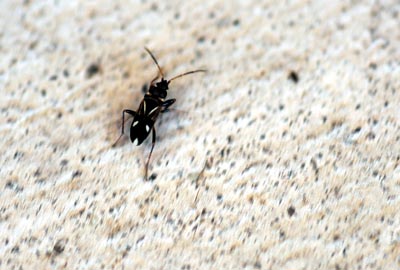Licha Rubio started noticing an influx of strange bugs
multiplying in her house and around her yard about three weeks ago.
They’re easily mistaken for ants without a closer look
– which reveals distinct cream-and-black abdominal marks that
inspired its name, the tuxedo bug – and they began increasing in
numbers, at one point blanketing portions of her back yard’s wood
fence and home’s windows.
Licha Rubio started noticing an influx of strange bugs multiplying in her house and around her yard about three weeks ago. They’re easily mistaken for ants without a closer look – which reveals distinct cream-and-black abdominal marks that inspired its name, the tuxedo bug – and they began increasing in numbers, at one point blanketing portions of her back yard’s wood fence and home’s windows.
At Rubio’s house in a cul-de-sac off Central Avenue and near Calaveras School, there were thousands of the “pissed” insects, as she described them. So she paid an exterminator to fumigate her home – three times – and she has tried to get help from the city, with little luck. Meanwhile, these less-than-gracious tuxedo bugs have not only stayed their ground, continuing to crawl furiously around her property, on furniture, on floors, just about everywhere, but they also seem to enjoy their stay quite a bit despite an apparent sense of paranoia, inherent with the insect, which keeps their legs chugging continuously.
“They’re just pissed,” Rubio said, pointing out their scrambling nature. “They’re getting bigger. They’re getting fatter. It seems like they follow the water.”
Rare to the area but inhabited throughout the West, according to a database on BugGuide.net, the tuxedo bugs are a genus in the plant bug family. They’re known as harmless, other than the annoyance factor, and they don’t bite.
For the past several weeks, though, they have been pestering Rubio and many other residents in two neighborhoods around the school, which had to hire a fumigator to spray the building perimeter, said Principal Christine White. Other county officials have gotten involved over the past week – including Agriculture Commissioner Ron Ross and Supervisor Jaime De La Cruz, who represents the area – by meeting with the neighbors.
Rubio at her home Friday contended that the sudden infestation is connected to the clearing of the nearby orchard, which borders the school and is separated from her property on the other side by about 100 feet. She and other perplexed neighbors first turned to the city for help. Rubio said the city’s involvement is appropriate because she believes the nuisance has been caused by the orchard property – because the owner cut down the trees and other vegetation in the spring and had it piled up, with some timber still remaining Friday.
Her theory, while unconfirmed, is that the bugs lost their temporary habitat when the orchard was cleared and they have ventured off to find new homes.
She has argued the city should step in to help, or force assistance from the nearby owner. Rubio, like other residents in a two- or three-block area affected by the infestation, has been in contact with Code Enforcement Officer Mike Chambless, whom she said has indicated it’s out of the local government’s jurisdiction. Chambless could not be reached immediately Friday afternoon or on Labor Day, and it’s unclear at this point who owns the orchard property.
School leaders have eliminated most of the tuxedo bugs on the campus, but the principal noted how some remain in the classrooms, that they’re “slowly dying off.”
White noticed the bugs when she had been walking around the weekend before the first day of school, which was Aug. 18.
“It just continued to get worse,” White said.
She recollected how district personnel initially had come to identify the insects – referring to it as a turf bug, another of its generic names – and how the worker had surmised their presence was due to the heat, that they would go away, eventually.
“Which was a nightmare,” White said. “They were falling from ceilings.”
Within a week, the school district had no choice and contracted with the exterminator. With few of the bugs now left, the principal said the school community is “just grateful” and eager to move on from the temporary nuisance.
“Everybody was talking – nothing but bugs,” White said.
Neighbors around the school are continuing to talk nothing but bugs, because the insects are finding comfort in nearby families’ homes. Claudia Nunez, Rubio’s neighbor, started seeing them about a month ago. Her family has tried “all different types of” repellents, but nothing has worked well and the tuxedo bugs continue crawling throughout the house.
“They’re just gross,” said Nunez, who hadn’t known what kind of insects have been bugging her family. “Nobody wants to have bugs inside.”
Nunez also has an 11-month-old daughter and expressed concern she might touch the insects if they’re crawling on carpet or toys.
“What if she sticks one in her mouth?” she said.
About two blocks away at a home along Central Avenue, Margaret Sandoval and her family have dealt with the unfriendly guests as well, but not to the extreme in the cul-de-sac area. Her family has had their property sprayed, too. Still, the tuxedo bugs remain.
“If I spray and my neighbor doesn’t spray, what good does it do?”










